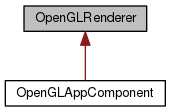A base class that should be implemented by classes which want to render openGL on a background thread. More...
#include <juce_OpenGLRenderer.h>

Public Member Functions | |
| OpenGLRenderer () | |
| virtual | ~OpenGLRenderer () |
| virtual void | newOpenGLContextCreated ()=0 |
| Called when a new GL context has been created. More... | |
| virtual void | openGLContextClosing ()=0 |
| Called when the current openGL context is about to close. More... | |
| virtual void | renderOpenGL ()=0 |
| Called when you should render the next openGL frame. More... | |
A base class that should be implemented by classes which want to render openGL on a background thread.
|
inline |
|
inlinevirtual |
|
pure virtual |
Called when a new GL context has been created.
You can use this as an opportunity to create your textures, shaders, etc. When the method is invoked, the new GL context will be active. Note that this callback will be made on a background thread, so make sure that your implementation is thread-safe.
Implemented in OpenGLAppComponent.
|
pure virtual |
Called when the current openGL context is about to close.
You can use this opportunity to release any GL resources that you may have created.
Note that this callback will be made on a background thread, so make sure that your implementation is thread-safe.
(Also note that on Android, this callback won't happen, because there's currently no way to implement it..)
Implemented in OpenGLAppComponent.
|
pure virtual |
Called when you should render the next openGL frame.
Note that this callback will be made on a background thread.
If the context is attached to a component in order to do component rendering, then the MessageManager will be locked when this callback is made.
If no component rendering is being done, then the MessageManager will not be locked, and you'll need to make sure your code is thread-safe in any interactions it has with your GUI classes.
For information about how to trigger a render callback, see OpenGLContext::triggerRepaint() and OpenGLContext::setContinuousRepainting().
Implemented in OpenGLAppComponent.